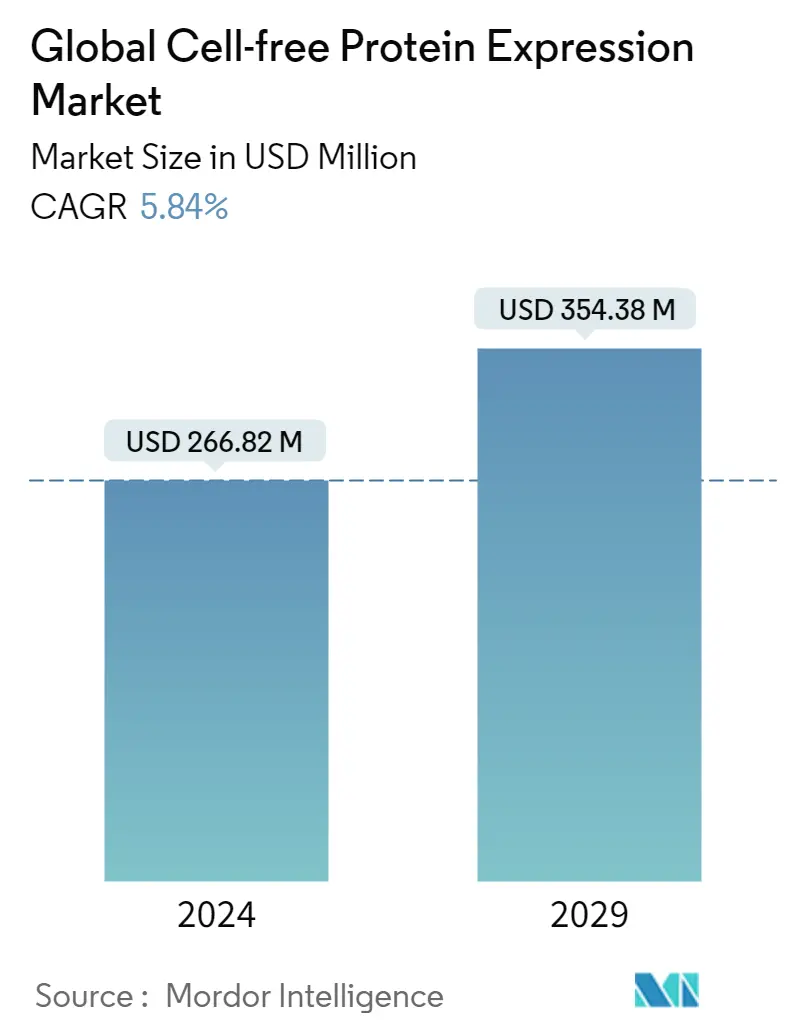Market Size of Global Cell-free Protein Expression Industry

| Study Period | 2019 - 2029 |
| Market Size (2024) | USD 266.82 Million |
| Market Size (2029) | USD 354.38 Million |
| CAGR (2024 - 2029) | 5.84 % |
| Fastest Growing Market | Asia-Pacific |
| Largest Market | North America |
Major Players
*Disclaimer: Major Players sorted in no particular order |
Need a report that reflects how COVID-19 has impacted this market and its growth?
Cell-free Protein Expression Market Analysis
The Global Cell-free Protein Expression Market size is estimated at USD 266.82 million in 2024, and is expected to reach USD 354.38 million by 2029, growing at a CAGR of 5.84% during the forecast period (2024-2029).
The market has a slightly positive impact due to the pandemic. Moreover, according to the article, "Harnessing proteomics could improve therapeutic approaches to COVID-19," published in November 2020, the development of therapeutic and preventive strategies requires an accurate understanding of proteins' role in the SARS-CoV-2 infection process and progression of COVID-19.
Furthermore, according to the article, "Scientists develop a high-throughput, cell-free screening platform for anti-SARS-CoV-2 antibody discovery," published in November 2021, Therapeutic monoclonal antibodies developed against the spike protein of SARS-CoV-2 have become a promising intervention to treat severely ill coronavirus disease 2019 (COVID-19) patients. However, the isolation, evaluation, and identification of the best antibody candidate require a series of time-consuming and labor-intensive experiments, including cloning, transfection, cell-based protein expression, protein purification, and critical assessment.
The significant factors for the growth of the cell-free protein expression market include the increasing R&D in proteomics and genomics, high prevalence of cancer and infectious diseases, and shorter-expression time and structural modification. Cell-free protein expression employs cell lysates to produce the desired recombinant proteins. The primary advantage of this technique is the aversion of workflow hurdles of maintaining cell culture or living cells. Cell lysates are produced by the breakdown and use of cellular components of eukaryotic or bacterial cells. Several cell-free protein expression systems are currently commercially available, based on E. coli, rabbit reticulocytes, wheat germs, human cell lines, and insect cells.
According to the article, 'Exploring the Potential of Cell-Free Protein Synthesis for Extending the Abilities of Biological Systems,' published in October 2019, Cell-free protein synthesis (CFPS) has the potential to overcome loopholes in the current in vivo production systems and is a promising tool in both primary and applied scientific research. It facilitates a simplified organization of desired experiments with various reaction conditions, making CFPS a powerful tool in biological research. It has been used to expand genetic code, assembly of viruses, and metabolic engineering to produce toxic and complex proteins. Subsequently, CFPS systems have emerged as a powerful technology for the high-throughput production of membrane proteins, enzymes, and therapeutics.
An in vitro protein expression system has significant advantages over living cell-based protein expression, including a shorter duration of the process, isotopic labeling of proteins, incorporation of non-natural amino acids, and optimization of protein complexes. In addition, the ability to enable high throughput production, the recent trend of more research in personalized medicine, and the growing need for biological therapies to manage cancer is significant driver for the adoption of cell-free protein expression techniques by pharmaceutical and biotechnology firms.
